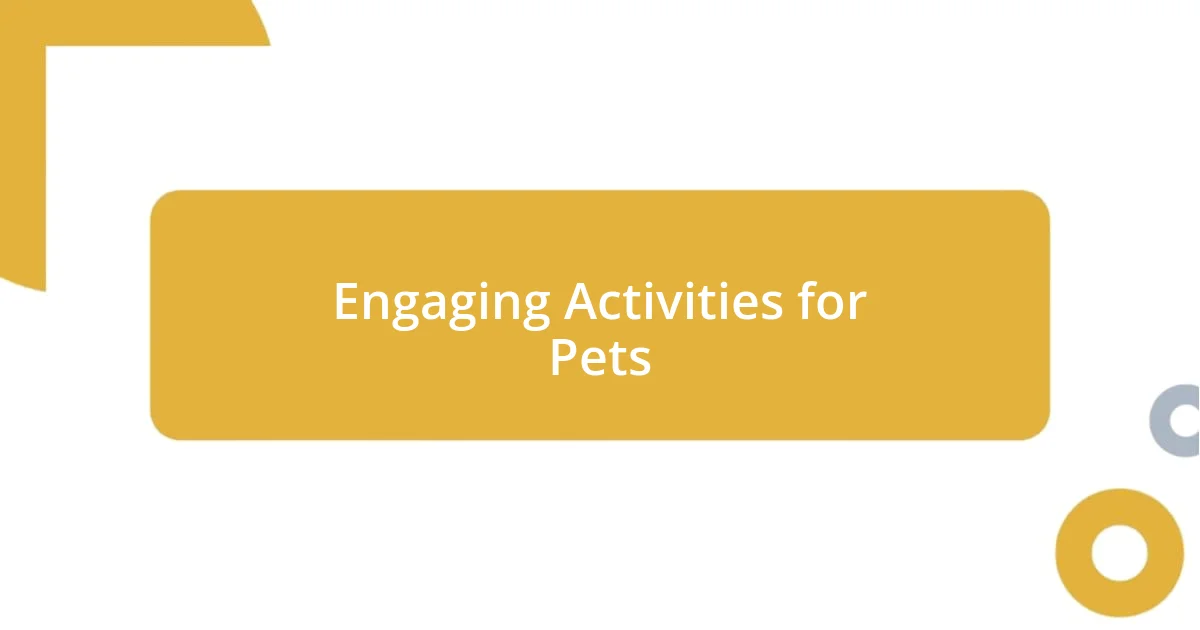Key takeaways:
- Pets often reflect the energy and emotions of their environment, showcasing changes in behavior based on socialization and surroundings.
- Creating a pet-friendly inn involves designated areas, comfortable accommodations, outdoor spaces, and staff trained in pet behavior to enhance the experience for both pets and owners.
- Building trust with pet owners through transparency, personalized care, and consistent routines fosters a supportive environment that benefits pets and their owners alike.

Understanding Pet Behavior Trends
When I observe pets at inns, I can’t help but notice how their behavior mirrors the environment and the energy of the guests. For instance, I’ve seen dogs who initially act shy and withdrawn transform into playful bundles of joy after a day of exploration and interaction with other pets and visitors. Isn’t it fascinating how pets can pick up on our emotions and respond in kind?
I remember a time I was staying at a quaint inn with my cat, Sophie. At first, she was a little on edge, sniffing every corner of our room. However, after a couple of hours, she started to stretch out and engage with the soft sounds of laughter and conversation from the nearby areas. This kind of transformation speaks volumes about how a pet’s comfort levels can fluctuate dramatically based on their surroundings.
Trends in pet behavior often fluctuate with the increase in socialization opportunities at inns, leading to heightened playfulness or anxiety depending on their individual experiences. I find it particularly interesting how some pets thrive in bustling atmospheres while others prefer quiet corners where they can observe from a distance. What does that say about their personalities? Ultimately, understanding these trends requires us to consider each pet’s past experiences, the social dynamics at play, and even their innate temperament.

Creating a Pet-Friendly Inn Environment
Creating a welcoming atmosphere for pets at inns is an essential factor in ensuring both pets and their owners have enjoyable stays. From my experience, I’ve found that simple adjustments can make a world of difference. For example, providing cozy bedding, designated play areas, and even pet-friendly treats can help pets feel more at home, alleviating stress for everyone involved.
Here are some key elements to consider when fostering a pet-friendly inn environment:
- Designated pet areas: Create spaces for pets to play and relax, away from high traffic zones.
- Comfortable accommodations: Offer beds, blankets, and toys to make pets feel at home.
- Pet-friendly dining options: Consider providing pet meals or snacks in your dining areas.
- Outdoor spaces: Maintain grassy areas for exercise and alleviate anxiety through exploration.
- Friendly staff training: Ensure staff understands pet behavior and can assist guests with their furry companions.
I remember a weekend at an inn that went above and beyond in creating a pet-friendly space. The moment we walked in, there was a warm welcome with treats for my dog, Max. On top of that, they had a charming garden where dogs could romp around freely. Max was all wagging tails and joyful barks, and I felt a wave of relief wash over me when I saw him enjoying his stay just as much as I did. It’s little moments like these that shape a memorable experience for both pets and their owners.

Positive Reinforcement for Pets
Positive reinforcement plays a crucial role in shaping pet behaviors during their stay at an inn. When pets receive praise, treats, or affection for desired behaviors, it not only encourages them to repeat those actions but also builds a stronger bond with their owners. I still remember the delighted look on my friend’s Golden Retriever, Leo, when he successfully learned to sit on command for a tasty treat. That little moment of triumph transformed his anxious demeanor into confident excitement, highlighting how effective positive reinforcement can be in nurturing good behavior.
Using positive reinforcement creates an environment where pets feel valued and understood. For instance, during my last trip, I noticed a timid beagle named Daisy who was often hesitant to join in the fun. However, when her owner calmly encouraged her with treats each time she ventured towards a group of playful dogs, Daisy started to gain confidence. It warmed my heart to witness her blossoming spirit as she finally joined in, showcasing how gradual reinforcement can stimulate socialization in nervous pets.
In essence, positive reinforcement not only reinforces desired behaviors but can also enhance the overall experience for pets in new environments. After all, who wouldn’t feel more relaxed and happy when their efforts are recognized? I believe that when inns embrace this approach, they create a vibrant atmosphere where pets and their humans can thrive together.
| Positive Reinforcement Technique | Example |
|---|---|
| Praise and Affection | Verbally praising a pet for laying calmly while you enjoy your meal. |
| Treats | Offering a small treat when your dog sits quietly during check-in. |
| Playtime | Engaging in play after a pet performs a desired behavior, such as fetching a ball. |

Engaging Activities for Pets
Engaging activities can transform an ordinary stay into an unforgettable adventure for pets at inns. I remember one particular inn that set up an agility course right in their backyard. Watching my spirited pup, Bella, navigate through tunnels and weave poles was pure joy! It not only kept her physically active but also mentally stimulated her, showcasing the value of interactive play.
Another engaging activity that I’ve seen work wonders is organized group games. During my last trip, a friendly staff member hosted a game of dog-friendly fetch with several guests and their pets. Imagine the delight on the dogs’ faces as they raced around, tails wagging and tongues lolling! It’s such moments that deepen the bond between pets and their owners while fostering a sense of community among fellow guests.
Let’s not forget about nature exploration! Many inns have trails nearby, and I always seize the opportunity for a good hike. I recall a mesmerizing experience walking along a forest path where Duke, my golden retriever, was in his element, sniffing and bounding with pure excitement. Engaging with the environment not only provides exercise but also opens up avenues for new experiences that pets thrive on. So, why not consider ways to enrich your pet’s stay, all while enjoying some quality time together?

Building Trust with Pet Owners
Building a solid foundation of trust with pet owners is essential within the inn environment. I always start by being open and transparent about the services provided, but it’s the little things that often make the biggest difference. For example, during one visit, I made it a point to send a quick photo update to a concerned pet owner whose dog was timid at first. Seeing her furry companion happily exploring the common area not only eased her worries but also solidified a sense of trust between us.
Creating an atmosphere where pet owners feel heard is vital too. There was a time when I had a guest express anxiety about leaving her cat while she dined. I took a moment to chat with her about her cat’s favorite treats and routines. After sharing my own experiences with anxious pets, her face lit up when I offered to check in on her cat throughout the evening. This personalized approach not only relieved her fears but helped establish a bond that was beneficial for both her and her pet.
Trust-building is also about consistency. I’ve noticed that when I adhere closely to routines and provide familiar comforts, like a cozy bed or favorite toy, the pets—and their owners—respond positively. During one stay, I set up a little welcome basket for a dog that included his owner’s recommended treats and toys. The look of relief on the owner’s face spoke volumes. It made me realize how crucial those thoughtful gestures are in deepening the connection with pet owners, showing them that their pets’ well-being is truly a shared priority.















